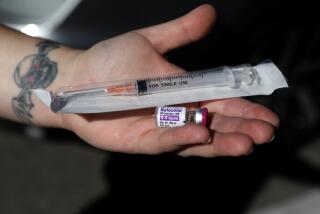Drug Shows Promise in Curbing Compulsive Gambling, Study Says
For the estimated 6 million compulsive gamblers in the U.S., the long odds are on a pill.
In the largest clinical study of its kind, researchers at the University of Minnesota found that daily doses of an experimental drug called nalmefene, often used to treat alcoholism, appeared to curb the craving to gamble.
The research represents the latest effort to control the biology of misbehavior at a time when celebrity poker, online gambling, lotteries and sports betting have helped to make obsessive wagering a national psychiatric disorder.
“The study is part of emerging evidence that gambling, once thought to be a problem in moral integrity, is instead a problem in brain biology and can be successfully treated,” said Dr. Robert Freedman, editor of the American Journal of Psychiatry, which published the study today in its February issue.
The study was sponsored by BioTie Therapies Corp., a Finnish biotechnology company that manufactures nalmefene.
The researchers tested the drug in a controlled trial involving 207 people undergoing treatment for compulsive gambling at 15 centers across the United States.
Almost two-thirds of the patients who were given nalmefene showed “significant” improvement during the four months of treatment, while about one-third of the patients in the placebo group responded favorably, the researchers reported.
About a third of the original participants dropped out due to nausea and other side effects.
The new compound “offers a real promise of hope for folks with this problem,” said Dr. Jon E. Grant, a University of Minnesota psychiatrist who led the study.
In efforts to treat pathological gambling, researchers have long sought some way to control cravings long enough for more conventional counseling to become effective.
Part of the difficulty is that compulsive gamblers often are not easily convinced that they have a problem.
“Gambling itself is quite pleasant,” Grant said. “It is the fallout -- bankruptcy, divorce, jail -- that is unpleasant. It is difficult to keep people in treatment.”
In the search for a biomedical solution, researchers have experimented with medications such as serotonin inhibiters and lithium, which have shown mixed results in limited studies.
One promising treatment for pathological gambling, involving a drug called naltrexone, has been linked to severe liver damage.
“Up to now, we only had inklings that a pharmacological agent would be successful,” said Grant, who said he had no financial stake in BioTie.
The key is to take the compulsive thrill out of winning and losing.
Nalmefene interferes with brain opiate circuits that process sensations of pleasure. It also indirectly affects the brain’s dopamine system, which handles feelings of reward.
Treated with nalmefene, the patients reported that gambling no longer seemed as thrilling or compelling.
“It is not a magic pill,” Grant cautioned. It may be most effective when used in conjunction with traditional counseling and therapy.
To better understand proper dosages, the researchers are conducting a second clinical trial involving 200 patients at 20 treatment centers, he said.






